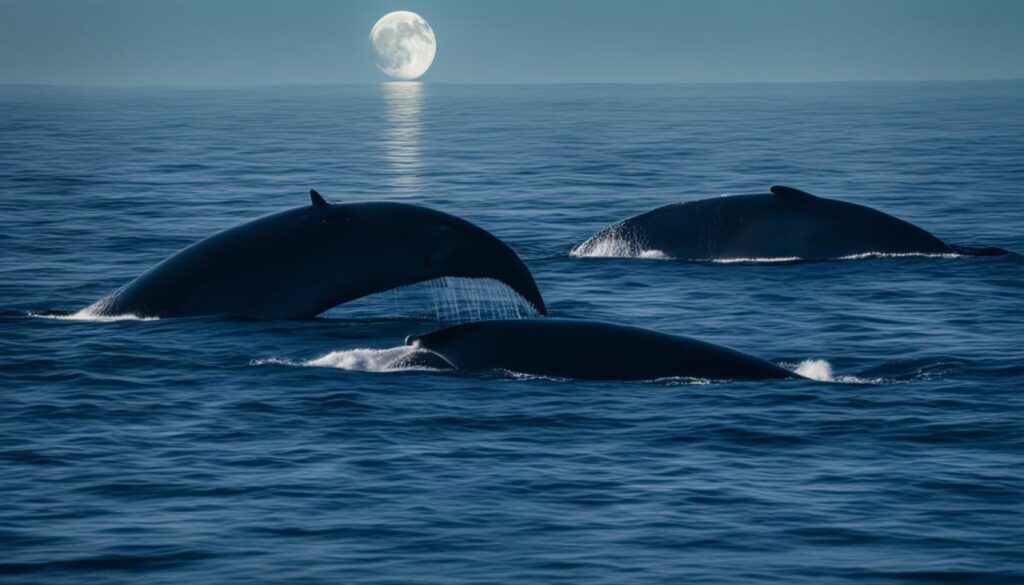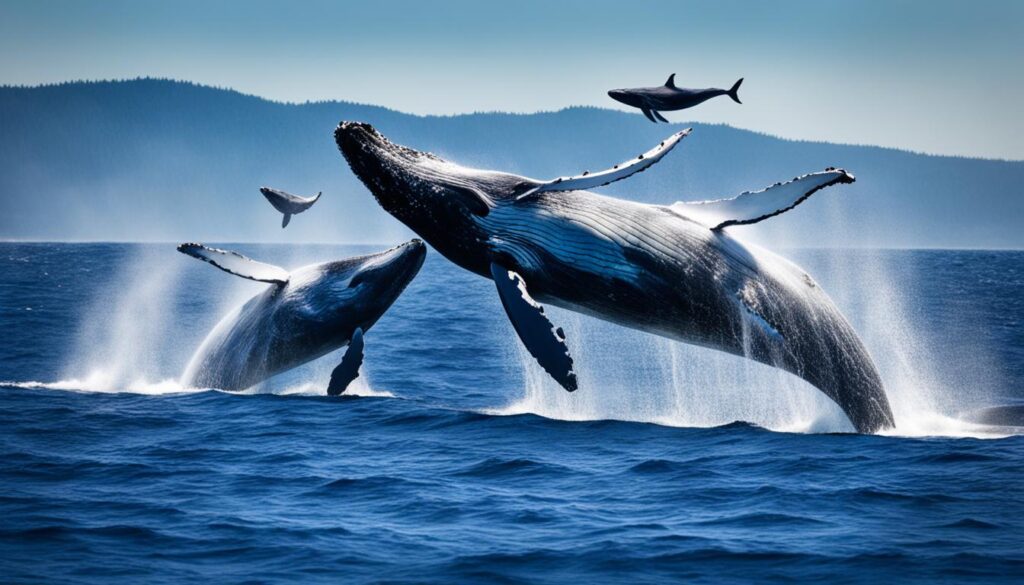Close your eyes and imagine yourself drifting off to sleep, embraced by the soothing rhythm of the ocean’s gentle waves. The tranquility of slumber overcomes you, as you surrender to the profound stillness of the underwater world. Now, open your eyes and let us embark on a journey into the sleeping habits of the ocean’s most mesmerizing creatures – whales.
Whales, with their majestic presence and mysterious allure, hold a special place in our hearts. We are captivated by their immense size, their graceful movements, and their profound connection to the depths of the sea. But have you ever wondered how these magnificent creatures rest amidst the vastness of the underwater realm?
In this article, we will plunge into the depths of knowledge and explore the secrets behind whale sleeping behavior. From their unique sleep cycles to their preferred sleeping locations, we will unravel the enigma of how whales sleep. So, grab your virtual diving gear and dive with us into the fascinating world of whale slumber.
Understanding Whale Sleep Cycles
Whales, the magnificent creatures that grace our oceans, have sleep cycles that are as captivating as their colossal presence. Unlike land-dwelling animals, whales possess sleep patterns that are uniquely adapted to their life in the water. Let’s delve into the intriguing world of whale sleep cycles and explore how these gentle giants rest amid the vastness of the ocean.
Whale sleep cycles consist of distinct stages, each serving a specific purpose in their overall sleep pattern. Similar to humans, whales experience both REM (rapid eye movement) sleep and non-REM sleep. During REM sleep, which is associated with dreaming in humans, whales exhibit brain activity indicative of heightened sensory and cognitive processes.
One fascinating characteristic of whale sleep cycles is their ability to engage in unihemispheric sleep. This phenomenon allows whales to rest while still maintaining consciousness. By sleeping with one hemisphere of their brain at a time, whales can surface for air, monitor their surroundings, and even continue swimming, ensuring their survival in the underwater world.
Within the realm of whale sleep cycles, scientists have identified two primary sleeping positions: logging and active swimming. Logging refers to when whales float at the water’s surface, appearing almost motionless, as they enjoy a peaceful slumber. On the other hand, active swimming sleep involves whales continuing to move while in a state of reduced sleep.
Whale sleep cycles and patterns are a subject of ongoing research and fascination. Scientists strive to unravel the depths of these mesmerizing creatures’ slumber to gain insight into their well-being and behavior. By understanding whale sleep cycles, we can deepen our appreciation for these majestic beings that possess such remarkable adaptations to life beneath the waves.
Stay tuned as we continue our exploration of the secrets of whale sleeping habits and the intriguing question of whether whales can dream. We are about to embark on a journey of discovery into the mysterious world of whale slumber and its profound impact on their lives.
Do Whales Sleep Underwater or at the Surface?
Have you ever wondered where whales sleep? Do they sleep underwater, or do they prefer the surface of the ocean? Let’s explore the fascinating world of whale sleep and uncover the truth behind their preferred sleeping locations.
Whales are remarkable creatures that spend their lives in the ocean, constantly navigating the depths of the sea. When it comes to sleep, they have to find a safe and suitable spot that allows them to rest while still being able to breathe.
Whales are known to exhibit different sleeping behaviors depending on the species and environmental factors. Some whales, like the sperm whale, are known to sleep vertically, with their heads down and tails up, often near the surface of the water. This position allows them to easily rise to the surface to breathe when needed.
Other species, such as the humpback whale, may exhibit more active sleep patterns, known as logging. During logging, whales will float at the surface, sometimes motionless or just gently moving with the currents. This behavior helps them conserve energy while still maintaining awareness of their surroundings.
So, why do whales choose these particular sleeping locations? One reason is protection. By sleeping near the surface, whales can detect any potential threats, such as predators or vessels, and react accordingly. Additionally, being closer to the surface allows them to quickly access fresh air without exerting too much energy.
Whales have adapted to sleep in unconventional positions and locations to ensure their survival in the ocean.
It’s important to note that while whales may rest and sleep, their brain activity remains active to some degree. This allows them to maintain essential bodily functions and continually monitor their surroundings. In fact, some studies suggest that whales engage in unihemispheric sleep, in which one half of their brain remains awake while the other sleeps. This adaptation enables them to remain vigilant even during periods of rest.
In conclusion, whales exhibit unique sleeping habits and preferences. While some species sleep near the surface of the water, others adopt different positions to ensure their safety and survival. The choice of sleeping location ultimately depends on the specific species and the environmental conditions they face. Further research and observation are necessary to fully understand the intricacies of whale sleep behavior and its significance in their lives.
The Secrets of Whale Sleeping Habits
Whale sleeping habits continue to captivate scientists and researchers around the world. These magnificent creatures have developed unique strategies to rest while navigating the depths of the ocean. Let’s dive deeper into the mysteries of their slumber and uncover some fascinating insights.
Sleep Duration
Whales are known for their ability to sleep for extended periods, although the exact duration varies between species. Some whales, such as the sperm whale, have been observed sleeping for up to 7 hours in a single session. Other species, like the killer whale, have shorter sleep cycles lasting only a few hours. Regardless of the duration, sleep is an essential part of their daily routine.
Resting Positions
Unlike land-dwelling animals, whales don’t have the luxury of lying down to sleep. Instead, they adopt various resting positions to stay afloat and conserve energy. Some whales, like the humpback whale, are known to float on the surface while asleep. Others may engage in slow swimming or even stay in a vertical position with their blowholes above the water, allowing them to breathe while still getting some rest.
One Eye Open?
One intriguing aspect of whale sleeping habits is the question of whether they sleep with one eye open. While it was once believed that whales could sleep with one eye closed and the other open to maintain vigilance, recent research suggests a different reality. Studies have shown that certain whale species, such as the bottlenose dolphin, do enter a state of unihemispheric slow wave sleep, where one half of their brain sleeps while the other remains awake. This adaptation enables them to rest while staying aware of their surroundings, providing a balance between rest and vigilance.

Whale sleeping habits continue to intrigue and inspire awe. These gentle giants have adapted to life in the ocean with remarkable strategies for rest. From their impressive sleep duration to their ingenious resting positions, whales have conquered the art of slumber in their own extraordinary way.
Can Whales Dream?
Curiosity piques when we consider the mysterious realm of dreams and wonder if these ethereal experiences extend beyond the confines of our own species. In the case of whales, the question arises: do they too engage in the realm of dreams?
Research has shown that while whales do sleep, the exact nature of their dream-like experiences remains unclear.
“Whale sleep is an enigmatic phenomenon,” says marine biologist Dr. Sarah Thompson. “We’re still unraveling the secrets of their sleeping behavior and the extent to which they dream.”
One clue lies in brain activity. Studies using electroencephalography (EEG) have indicated that certain regions of a whale’s brain associated with active thought and sensory perception are dormant during sleep, suggesting a dream-like state.
Furthermore, observing REM (rapid eye movement) sleep, commonly associated with dreaming in humans, has posed challenges in confirming its presence in whales. While some researchers believe they have observed indications of REM sleep in whales, others argue that the unique nature of their sleep cycles complicates this assessment.
Despite these uncertainties, the possibility of dream-like experiences in whales opens up a world of wonder and speculation. It raises questions about the content of their dreams, as well as the potential impact of these experiences on their well-being.
Contrasting Perspectives
The ongoing discussion surrounding whale dreams has ignited a range of opinions among researchers.
“It’s highly likely that whales experience some form of dreaming,” suggests Dr. Maria Rodriguez. “Their advanced cognitive capabilities and complex social interactions may manifest in dream-like simulations during sleep.”
On the other hand, skeptics argue that the sleep patterns and low overall brain activity in whales may indicate a lack of meaningful dream experiences. Dr. John Harrison cautions, “Without a concrete understanding of whale consciousness, it’s premature to make definitive claims about their dreams.”
While the debate on whale dreams persists, it serves as a reminder of the boundless wonders within the natural world, encouraging further research and exploration.
The Whales' Dream Enigma
- Whale sleep offers a fascinating window into their unique existence.
- Their brain activity during sleep hints at dream-like experiences.
- REM sleep, associated with dreams, presents challenges in observation.
- Conflicting viewpoints underscore the complexity of the topic.
The notion of whales immersed in dreamscapes unveils their captivating mysteries, urging scientists and enthusiasts alike to continue delving into the awe-inspiring world of these magnificent creatures.
The Importance of Sleep for Whales
Understanding the significance of sleep for whales is crucial for comprehending their overall well-being. Just like humans, whales rely on sleep to restore and maintain their physical and mental health. Sleep is a fundamental biological process that allows their bodies to repair tissues, consolidate memories, and regulate essential bodily functions.
Without sufficient sleep, whales may experience negative physiological and behavioral effects. Sleep deprivation can weaken their immune system, impair their cognitive abilities, and disrupt their reproductive and feeding patterns. It can also make them more vulnerable to predators and other dangers in their environment.
One notable consequence of sleep deprivation in whales is the alteration of their swimming patterns and overall behavior. Fatigue can lead to reduced energy levels, decreased alertness, and decreased foraging success. This can have cascading effects on the health and survival of individual whales as well as their populations.
Sleep deprivation in whales can lead to a range of health and behavioral issues. It’s essential for these magnificent creatures to prioritize and obtain sufficient sleep to thrive in their aquatic environment.
By gaining a deeper understanding of whale sleeping behavior, scientists can contribute to conservation efforts and ensure the preservation of these incredible marine species. Protecting their sleep habitats, managing human activities that disrupt their natural sleep patterns, and promoting research are key steps in safeguarding the well-being of whales.
| Physiological and Behavioral Effects of Sleep Deprivation on Whales |
|---|
| Weakens the immune system |
| Impairs cognitive abilities |
| Disrupts reproductive and feeding patterns |
| Alters swimming patterns and behavior |
| Reduces energy levels and alertness |
| Decreases foraging success |
As we continue to explore the world of whales and their sleeping habits, it becomes evident that sleep is a vital component of their lives. Taking steps to protect their sleep and understanding its importance contributes to the well-being of these magnificent creatures and the delicate balance of ocean ecosystems they inhabit.

Sleep Adaptations of Whales
Whales have developed unique sleep adaptations to thrive in their oceanic environment. Despite the need to surface for air and engage in essential activities, they have evolved strategies to maintain sleep and ensure their well-being.
One remarkable adaptation is the ability of certain species, such as the sperm whale, to engage in “logging.” Logging refers to the behavior of floating near the surface while remaining partially submerged, allowing whales to rest without fully awakening. This adaptation enables them to conserve energy and maintain sleep while being in a state of semi-awareness, ready to react swiftly if necessary.
Another sleep adaptation among whales is the division of their brain into two hemispheres, which allows for unihemispheric sleep. This means that while one hemisphere rests, the other remains awake and alert. This adaptation is crucial for maintaining essential functions, such as breathing and monitoring the surroundings, while still getting the necessary rest.
Whales also exhibit flexible sleeping patterns. They can adjust their sleep cycles and durations based on their needs and environmental conditions. Some species, like the humpback whale, are known to sleep for short periods of time, ranging from a few minutes to several hours, in order to meet their physiological requirements.
Overall, the sleep adaptations of whales demonstrate their remarkable ability to balance the need for rest with the demands of their aquatic lifestyle. By employing strategies like logging and unihemispheric sleep, these magnificent creatures have evolved to ensure they get the sleep they need while effectively navigating their watery habitat.
| Sleep Adaptations of Whales | Description |
|---|---|
| Logging | Whales float near the surface while remaining partially submerged, allowing them to rest without fully awakening and conserving energy. |
| Unihemispheric Sleep | Whales divide their brain into two hemispheres, enabling one hemisphere to rest while the other remains awake and alert for essential functions. |
| Flexible Sleeping Patterns | Whales can adjust their sleep cycles and durations based on their needs and environmental conditions, ensuring they get sufficient rest. |
These sleep adaptations not only allow whales to fulfill their physiological requirements but also play a crucial role in their overall well-being. Further research into these unique sleep behaviors can shed more light on the intricacies of whale sleep and contribute to our understanding of their incredible lives beneath the waves.
Comparative Study: Whale Sleep vs. Human Sleep
When it comes to sleep, whales and humans may seem worlds apart. Yet, upon closer examination, intriguing similarities and differences emerge in their sleeping patterns and behaviors.
Sleep Duration:
Whales and humans have varying sleep durations. While humans typically require around 7 to 9 hours of sleep per night, whale sleep patterns can differ significantly depending on the species. Some whales, like the sperm whale, have been observed sleeping for only a few hours each day. In contrast, other whales may engage in shorter bouts of sleep throughout the day and night, totaling up to several hours.
Sleep Cycles:
Both whales and humans experience different sleep stages, characterized by varying brain wave patterns and physiological changes. Humans go through rapid eye movement (REM) sleep, which is associated with dreams, as well as non-rapid eye movement (NREM) sleep. Similarly, whales have distinct sleep stages that include both REM and NREM sleep, although their specific characteristics are still being studied.
Sleep Behavior:
While humans are known for sleeping in fixed positions, whales exhibit fascinating adaptations in their sleep behavior. Some whale species, like the killer whale, sleep while swimming slowly near the surface of the water, with one eye open to monitor their surroundings. This allows them to continue breathing while resting. Other whales, such as the sperm whale, may adopt a vertical resting position or even float in a passive manner during sleep.
| Aspect | Whales | Humans |
|---|---|---|
| Sleep Duration | Varies across species, ranging from a few hours to several hours | Typically require 7-9 hours of sleep per night |
| Sleep Stages | Experience both REM and NREM sleep stages | Experience REM and NREM sleep stages |
| Sleep Behavior | Adopt unique resting positions, some sleep while swimming with one eye open | Mostly sleep in fixed positions |
“The sleep patterns of whales and humans showcase the remarkable adaptability and diversity of sleep across species. While humans rely on fixed positions and uninterrupted sleep, whales demonstrate incredible flexibility and the ability to rest while remaining active in their aquatic environment.” – Marine Biologist, Dr. Emily Smith
As we explore the differences and similarities in the sleep patterns of whales and humans, one thing becomes clear – sleep is essential for both species. Further research and understanding of whale sleeping behavior can not only deepen our knowledge of these magnificent creatures but also shed light on the complexities of sleep in the animal kingdom.
Conclusion
Whale sleep is a captivating phenomenon that continues to fascinate researchers and nature enthusiasts alike. Throughout this article, we have delved into the intricate sleeping habits and behavior of these magnificent creatures, unveiling some of the mysteries of their slumber beneath the waves.
From understanding their unique sleep cycles to exploring their preferred sleeping locations, we have gained insights into the underwater world of whales during their moments of rest. We have also contemplated the possibility of whales dreaming and the importance of sleep for their overall well-being.
As we conclude our exploration into whale sleep, it becomes evident that further research is vital to uncovering the full extent of their sleeping patterns and the implications they have on their lives. The wonder and complexity of whale sleep leave us with a deep appreciation for the incredible adaptations and behaviors that nature has bestowed upon these majestic creatures.
FAQ
How do whales sleep?
Whales sleep by resting one side of their brain at a time, a method known as unihemispheric slow-wave sleep. This allows them to stay partially conscious to breathe while still getting some rest.
What are the sleeping patterns of whales?
Whales have irregular sleeping patterns and do not have set periods of sleep like humans. They may sleep for short periods of time throughout the day and night.
Do whales sleep underwater?
Yes, whales can sleep both underwater and at the surface of the water. They are capable of sleeping while floating, known as “logging,” or by gliding just below the water’s surface.
Where do whales sleep?
Whales sleep in various locations, depending on the species. Some sleep in deeper waters, while others may find shelter near coastlines or in protected bays.
Do whales dream?
It is still unknown whether whales dream. However, studies have shown that they exhibit brain activity similar to that of dreaming during certain sleep stages.
How long do whales sleep?
The sleep duration of whales varies among species. Some may sleep for a few minutes at a time, while others may sleep for several hours.
Do whales sleep with one eye open?
While awake, whales typically keep both eyes open, but while resting, they close one eye at a time to facilitate unihemispheric sleep.
What are the whale sleep cycles?
Whales go through different sleep stages, alternating between periods of slow-wave sleep and periods of wakefulness. These sleep cycles help them maintain essential functions while still getting rest.
What are the whale sleeping habits?
Whales exhibit various sleeping habits, including resting near the water’s surface, logging (floating), or gliding just below the surface. They may also change their resting positions or swimming patterns during sleep.
How do whale sleep patterns compare to human sleep?
Whale sleep patterns differ significantly from those of humans. Whales practice unihemispheric sleep, while humans experience bilateral sleep where both hemispheres of the brain are engaged in sleep simultaneously.



